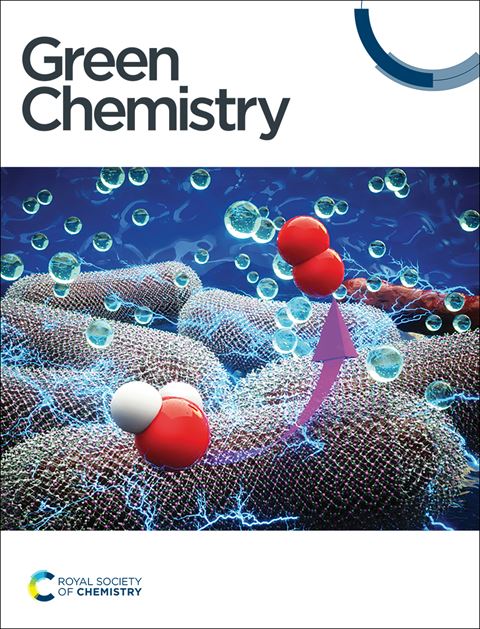Anodic electrochemical C–C bond cleavage co-catalyzed by ionic liquids and FeNi@C for lignin upgrading†
IF 9.3
1区 化学
Q1 CHEMISTRY, MULTIDISCIPLINARY
引用次数: 0
Abstract
Electrochemical oxidation of lignin for the production of high-value aromatic aldehydes, while co-generating hydrogen, represents a promising strategy to achieve dual benefits. However, the selective electrochemical cleavage of the nonpolar and robust C–C bonds in lignin presents tremendous challenges. Here, FeNi@C derived from metal–organic frameworks (MOFs) is designed for the high-selectivity electrochemical oxidation of the lignin model compound veratrylglycerol-β-guaiacyl ether (VG) to achieve C–C bond cleavage, resulting in the production of veratraldehyde (VAld). Moreover, a trace amount of an ionic liquid (IL) additive is incorporated into the electrolyte to further optimize the selectivity for VAld. In an anion exchange membrane (AEM) single cell, the FeNi@C anode, under the synergistic catalytic effect of BmpyrroCl, demonstrates a remarkable conversion efficiency of up to 89.8% for VG, with the yield and selectivity of VAld reaching 63.9% and 70.1%, respectively. Notably, this approach demonstrates exceptional performance in lignin upgrading, achieving an aromatic aldehyde yield of 23.5 wt%, with VAld showing a yield and selectivity of 7.3 wt% and 31.1%, respectively, highlighting its significant practical potential. In situ electron spin resonance (ESR) analysis and density functional theory (DFT) calculations reveal that the exceptional selectivity of FeNi@C for VAld is attributed to the ability of Fe to serve as an electronic conversion switch, regulating the valence state of Ni. Specifically, it enhances the formation of highly active Ni3+δ at 1.4 V, fostering C–C bond dissociation while mitigating the continuous oxidation of Ni3+δ to higher valence states, thereby inhibiting the undesired conversion of VAld to veratric acid (VAc). The Gaussian calculation results indicate that the strong hydrogen bond between the ILs and Cα–OH promotes the preactivation of VG, thus exerting a synergistic catalytic effect on FeNi@C.

求助全文
约1分钟内获得全文
求助全文
来源期刊

Green Chemistry
化学-化学综合
CiteScore
16.10
自引率
7.10%
发文量
677
审稿时长
1.4 months
期刊介绍:
Green Chemistry is a journal that provides a unique forum for the publication of innovative research on the development of alternative green and sustainable technologies. The scope of Green Chemistry is based on the definition proposed by Anastas and Warner (Green Chemistry: Theory and Practice, P T Anastas and J C Warner, Oxford University Press, Oxford, 1998), which defines green chemistry as the utilisation of a set of principles that reduces or eliminates the use or generation of hazardous substances in the design, manufacture and application of chemical products. Green Chemistry aims to reduce the environmental impact of the chemical enterprise by developing a technology base that is inherently non-toxic to living things and the environment. The journal welcomes submissions on all aspects of research relating to this endeavor and publishes original and significant cutting-edge research that is likely to be of wide general appeal. For a work to be published, it must present a significant advance in green chemistry, including a comparison with existing methods and a demonstration of advantages over those methods.
 求助内容:
求助内容: 应助结果提醒方式:
应助结果提醒方式:


